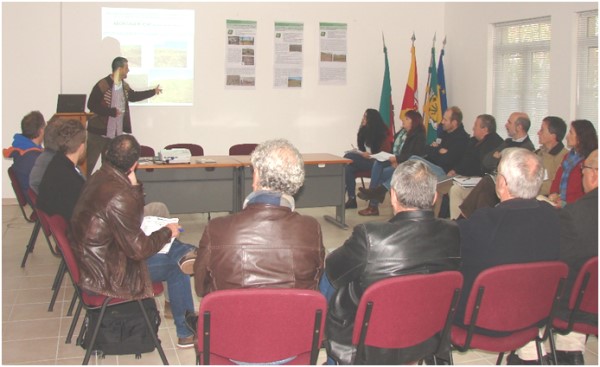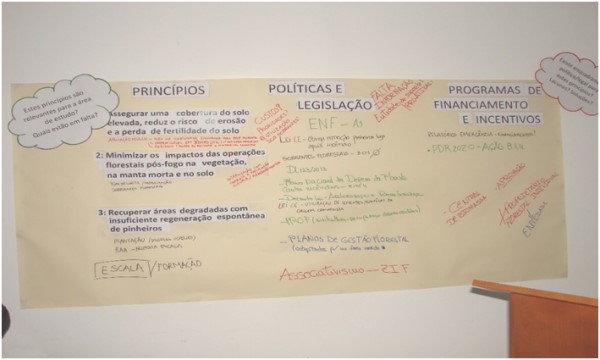| Main authors: | Cecilia De Ita, Lindsay C. Stringer, Luuk Fleskens, Diana Sietz |
| Contributing authors: | Ioannis K. Tsanis, Ioannis N. Daliakopoulos, Ioanna Panagea, Michalakis Christoforou, Giovanni Quaranta, Rosanna Salvia, Sandra Valente, Cristina Ribeiro, Cláudia Fernandes, Oscar González-Pelayo, Jan Jacob Keizer, Alejandro Valdecantos, V. Ramón Vallejo and Susana Bautista |
| Editor: | Jane Brandt |
| Source document: | De Ita, C. et al. (2017) Report on multi-scale evaluation of CASCADE's management principles and grazing model scenarios with stakeholders and policy makers. CASCADE Project Deliverable 8.3 69 pp |
Based on their previous engagement in CASCADE’s participatory activities, 14 stakeholders were selected to participate in the final workshop in Portugal (Figures 1 and 2). Twelve stakeholders were able to attend, including representatives of governmental and non-governmental organizations, local forest owners and representatives of the private sector.
In Portugal the management principles focused on post-fire management, as the study sites were pine forest plantations. Pine trees typically die during or shortly after a fire, therefore, they need to be logged rapidly to recover some of the value of the standing wood. Furthermore, the pines need to be cut because of phytosanitory regulations related with combating the pine nematode. Consequently post-fire principles were tailored to the Várzea region by the Portuguese team.


Stakeholders’ perceptions of post-forest fire management principles
In the Portuguese study site land abandonment takes place. The occurrence of land abandonment and forest fires is interlinked and it interacts with other factors. Broadly, land abandonment can occur as a consequence of forest fires, and in turn, large forest fires can be exacerbated due to land abandonment. For this reason CASCADE researchers in Portugal focused on post-fire principles rather than land abandonment per se.
Workshop participants believed the absenteeism of land owners from active land management in the Várzea area to be similar to that in the rest of the Portugal. Rural exodus was associated with the search for better living conditions and means that the remaining rural population is generally comprising older people; however, outmigration was also recognised as contributing to more frequent and intense forest fires. Therefore, workshop participants first referred to absenteeism of forest owners as a major constraint when asked about the feasibility of the implementation of the post-fire management principles. This lack of intervention is aggravated in areas where natural regeneration is insufficient.
For descriptions of the principles discussed here, see »Guidelines for land managers: the forest fire context_EN
Regarding principle 1.1 “Ensuring high soil cover, both after fire and after post-fire forestry operations, reduces the risk of erosion and of soil fertility losses” the stakeholders recognized the importance of maintaining high soil cover in order to reduce soil erosion. However, a difference was perceived between areas of pine forest that were affected by fire once in 30 years and areas affected by recurrent fires. Stakeholders recognised that areas that have been rarely affected needed less human intervention. In contrast, recurrent fires over short time intervals lead to low rates of spontaneous recruitment, and therefore seeding or planting are needed to maintain forested areas and avoid shrubland expansion.
As a result of CASCADE’s experiments regarding mulching effectiveness, stakeholders agreed that application of mulch was desired in areas with a high level of disturbance. According to stakeholders and similar to the situation in Spain, the benefits of mulching are little known by the stakeholders. An awareness campaign regarding its effects, including the minimisation of off-site effects, for example, surface water quality restoration, was proposed. However, it was mentioned that mulching represents high costs, which neither the public sector nor the private sector are prepared for or capable of supporting. Participants agreed that the forest owners would not be willing or able to pay the costs of transport of the organic residues to be applied and the costs of their application. However, in order to minimize the costs of mulching, one of the participants suggested the transfer of forest residues from locations where these residues are in excess to the areas to be mulched. Another alternative to minimize costs of mulching, was to use a local centre for logging residues destined for biomass energy plants, as stakeholders expected that the payments would allow to cover the costs of mulching with the remaining, smaller logging residues.
The second post-fire principle “Minimize the impacts of post fire forest operations (logging and extraction of wood and logging residues) on vegetation, litter and soil” raised some controversy among the participants. Two types of logging were presented by CASCADE researchers: traditional logging (logging and removal of wood material over the entire plantation) and conservation logging (logging, and partial removal of wood material, in strips only). Some stakeholders disagreed with the conservation logging technique. One of the reasons indicated was that the machinery used for making piles of forest residues damaged vegetation cover. Other reasons were that these piles were hiding places for animals that eat pine seeds, thereby limiting natural regeneration, and that the tracks being used were prone to runoff generation and erosion. After discussions, the participants agreed that conservation logging has some benefits over the short term, but that traditional logging is to be preferred in the long term and that it should be the recommended logging practice.
Common forestry operations can have negative effects on vegetation (including pine recruitment) as well as on the soil, especially through soil compaction on tracks. Furthermore, stakeholders perceive that forestry operations can reduce the effectiveness of mulching, so that mulching ought to be postponed till after logging has been completed, when most of the post-fire erosion has already occurred.
Regarding principle 3 “Recover degraded areas with lack of spontaneous regeneration of pine trees”, the practical difficulties of seeding raised some discussion. European laws require use of seeds from a known origin when afforestation has a production purpose, which introduces some difficulties when purchasing the seeds. This obligation was unknown to some of the workshop participants, which then ultimately led to the affirmation that forest owners in the Várzea often lacked the knowledge and the technical support from the responsible authorities. Therefore, support to accompany the ongoing technological developments and changes in policy was needed. As a result, even motivated forest owners are not always aware of how to properly take care of their land according to European laws.
During the CASCADE workshops in Portugal a new principle was developed by stakeholders through the participatory approach. The lack of technical support along the multitude of land owners, inspired a new principle “Increase the scale for forest management (land consolidation, Forest Intervention Area, Forest owners’ organization, etc)”. This responds to an issue that came up on various occasions throughout the workshop, and reflects the importance of the predominantly small size of forest properties in constraining forest management and application of the principles in Portugal and in particular, post-fire land management and rehabilitation of degraded burnt areas.
Note: For full references to papers quoted in this article see
